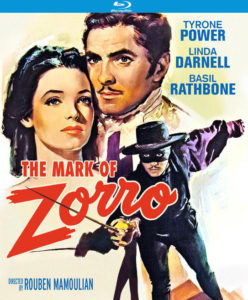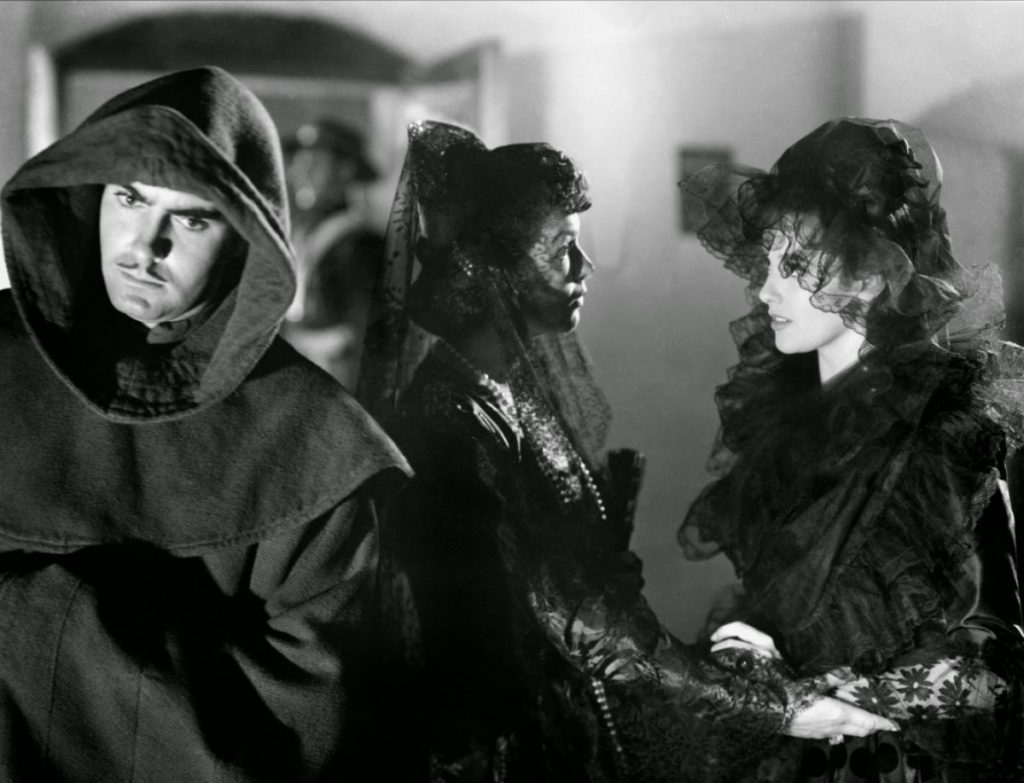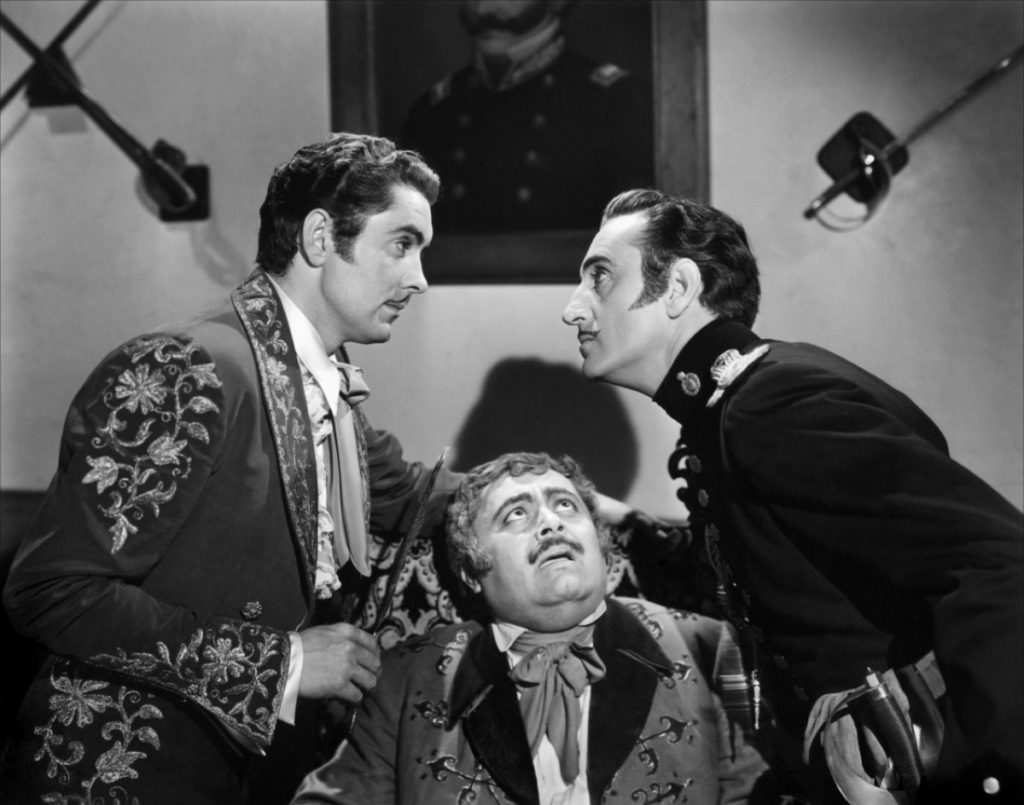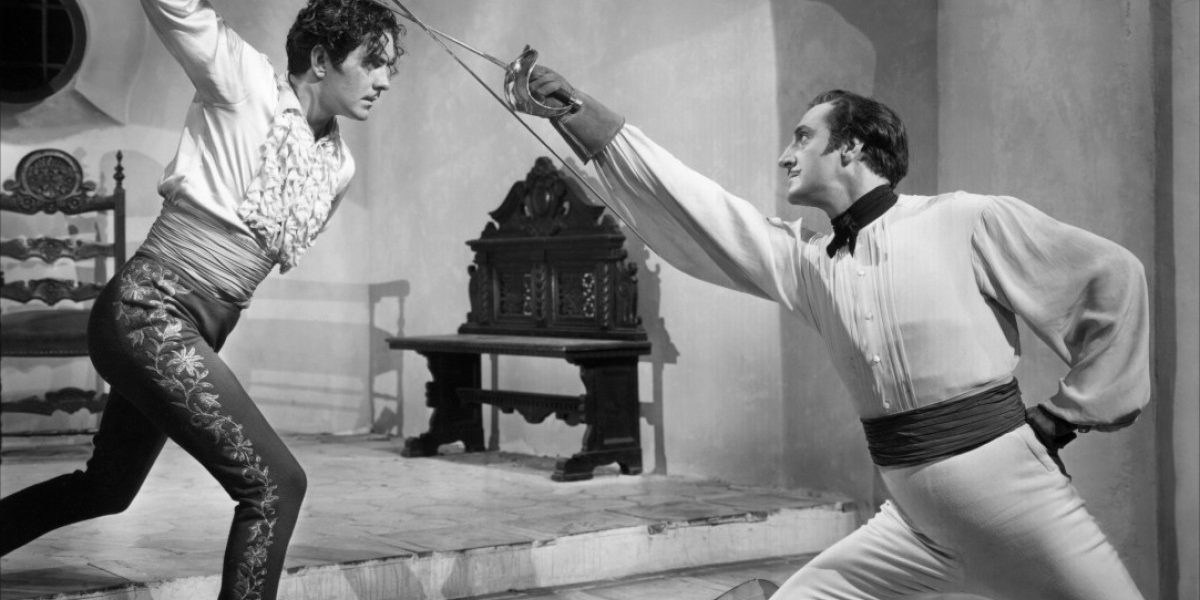Who Was That Masked Man?
DIRECTED BY ROUBEN MAMOULIAN/1940
STREET DATE: August 2, 2016/KINO LORBER
 Remaking Douglas Fairbanks’ silent-era costume adventure classic The Mark of Zorro (1920), 20th Century Fox recruited their top box office draw Tyrone Power in the studio and star’s initial bid for swashbuckling screen glory. Though rival studio Warner Brothers had dominated the genre with their series of lavish historical adventures, many of which starred their own top box office draw Errol Flynn (Captain Blood [1935], The Prince and the Pauper [1937], The Adventures of Robin Hood [1938]), Fox’s first foray into sabers-clinking, barricades-leaping, horse hooves-pounding masked marauding proved a change of direction both for the studio and its greatest star. With the success of The Mark of Zorro, 20th Century Fox and Tyrone Power became synonymous with “action” and “adventure”.
Remaking Douglas Fairbanks’ silent-era costume adventure classic The Mark of Zorro (1920), 20th Century Fox recruited their top box office draw Tyrone Power in the studio and star’s initial bid for swashbuckling screen glory. Though rival studio Warner Brothers had dominated the genre with their series of lavish historical adventures, many of which starred their own top box office draw Errol Flynn (Captain Blood [1935], The Prince and the Pauper [1937], The Adventures of Robin Hood [1938]), Fox’s first foray into sabers-clinking, barricades-leaping, horse hooves-pounding masked marauding proved a change of direction both for the studio and its greatest star. With the success of The Mark of Zorro, 20th Century Fox and Tyrone Power became synonymous with “action” and “adventure”.
Which is why it is a little curious to sit down with The Mark of Zorro some 75 years later on Kino Lorber’s upcoming Blu-ray release and note how comparatively little action and adventure is actually contained in the film. Opening in Spain with an expansive scene of Don Diego Vega (Power) and his rigorously-choreographed martial education at a Madrid military academy, the scene shifts to the dusty Californian pueblo of Los Angeles as Don Diego returns to the place of his birth, called back home by his father, the former Alcade Don Alejandro Vega (Montagu Love). There, Don Diego learns the Spanish colony is under the dictatorial control of the new Alcade, Don Luis Quintero (J. Edward Bromberg), a cowardly and corrupt official who cheats and abuses the local peasants for his own gain, and who derives his unjust authority from an armed garrison commanded by the ruthless and dastardly Captain of the Guards, Esteban Pasquale (Basil Rathbone). Donning the disguise of an effete fop who peers through a lorgnette, performs magic tricks, and wearily delivers withering bon mots, Don Diego further dons the disguise of the mask-wearing, night-riding, Z-slashing Zorro!, stamping out injustice and villainy in all its multifarious forms.

With Don Diego/Zorro’s romantic interest, both real and pretended, divided between the genuine and virginal Lolita Quintero (Linda Darnell), niece of the Alcade, and the false and scheming Inez Quintero (Gale Sondergaard), wife of the Alcade, The Mark of Zorro devotes much of its running time to the various guises and deceptions of the foppish dandy/costumed hero. Stealthily stalking about the villains’ stronghold one minute, in his guise as Zorro, and tiresomely complaining about his “tepid” bath water the next, as Don Diego, the film itself threatens to devolve into tepidity if not for some truly stunning action sequences. With Zorro’s day-for-night escape from the Alcade‘s lair, the director and his stunt coordinators fashion a marvelously camera-undercranked leap over a sheer wall and onto a horse; soon zipping through a canyon, and, while still on the horse, over a bridge and into a ravine as the night-clad rider once again eludes his clumsy pursuers. Most famous, however, and even iconic, is Don Diego and his climactic fencing duel with Captain Pasquale, in which the former finally and definitively discards his foppish guise! Commencing with the pair swiping a pair of candles in twain with their sabers (Don Diego’s cut is so clean that his candle actually remains standing!), the close-quarters combat between Tyrone Power and Basil Rathbone is a masterpiece of fast-paced, swords-rattling theatrics.
…

Kino Lorber’s Blu-ray upgrade of this worthy swashbuckler in particular highlights cinematographer Arthur C. Miller’s bold, high-contrast and low-lit compositions, which are unusually effective and atmospheric as Zorro skulks through the shadow-drenched interiors or peers around a dark corner, eyes blazing through his mask. Miller had a long career going literally back to The Perils of Pauline (1914), and had been instrumental in establishing a “house style” for 20th Century Fox productions of the 1930s, working often with John Ford, and later winning an Academy Award for How Green Was My Valley (1941). Here, Miller imbues the brooding and candle-lit images with a subtle intensity which was all but invisible on previous home video releases. The gray tones and “filmic” graininess finally stand in stark relief to the chiaroscuro-like backgrounds for home audiences, and viewing the clarity of The Mark of Zorro‘s images reminded this viewer of clear stylistic links between visually-oriented silent cinema and the film noir-like visuals that would more frequently emerge in Hollywood movies of the 1940s. Charming hisses and pops aside, derived from the soundtrack’s original monaural elements, Alfred Newman’s rousing score fairly thundered through, and even overwhelmed, my screen monitor’s speakers, and the rattling, clinking, and pounding of swashbuckling savoir faire will adequately fill a home auditor’s living room to desired levels of adventurous derring-do.
In addition to an informative late 1990s A&E documentary Tyrone Power: The Last Idol, giving a thorough overview/introduction to this important Hollywood star’s life and career, also included on this Blu-ray disc are a pair of original trailers for the Tyrone Power Western Rawhide (1951) and his crucial, late-career supporting role in Billy Wilder‘s Witness for the Prosecution (1958). But the biggest surprise for this DVD/Blu-ray buff was film historian/critic Richard Schickel’s perceptive and even enthusiastic feature-length commentary. While measured in his praise of the film and genre from which it derives, Schickel delivers cogent analysis of notorious screen perfectionist Rouben Mamoulian (Dr. Jekyll and Mr. Hyde [1931], Love Me Tonight [1932], Queen Christina [1934]), particularly his gift for visual composition and choreographed screen movement, along with how the director specifically dealt with the constraints of filming this budget-limited production on the backlots of 20th Century Fox. Moreover, in explicating some of the tropes and conventions of the swashbuckling genre, and Classic Hollywood filmmaking in general, Schickel raises some interesting questions on how we view older cinema and how/why we should appreciate it. Though Schickel’s commentary track ends on the ominous words of “…failure and mortality”, I nonetheless gained a new appreciation for this crisp and efficient piece of classic filmmaking, and the personalities and technicians who contributed to my 95 minutes of home-viewing enjoyment.
The images used in the review are present only as a reference to the film and are not meant to reflect the actual image quality of the Blu-ray. (As a further note, I would like to point out the to-me enjoyable irony that “Zorro” is in fact Spanish for “Fox”. I feel remiss that I was not able to incorporate the observation in the review.)


